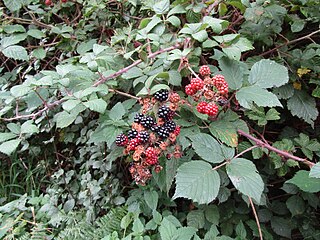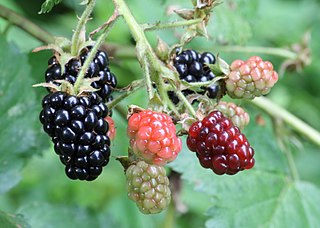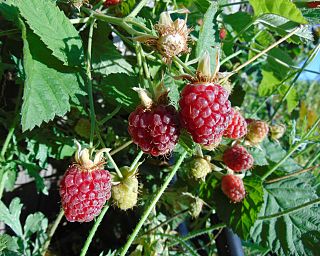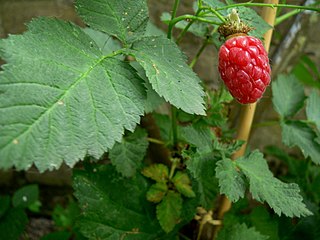
A berry is a small, pulpy, and often edible fruit. Typically, berries are juicy, rounded, brightly colored, sweet, sour or tart, and do not have a stone or pit, although many pips or seeds may be present. Common examples of berries in the culinary sense are strawberries, raspberries, blueberries, blackberries, white currants, blackcurrants, and redcurrants. In Britain, soft fruit is a horticultural term for such fruits.

Rubus is a large and diverse genus of flowering plants in the rose family, Rosaceae, subfamily Rosoideae, commonly known as brambles. Fruits of various species are known as raspberries, blackberries, dewberries, and bristleberries. It is a diverse genus, with the estimated number of Rubus species varying from 250 to over 1000, found across all continents except Antarctica.

The blackberry is an edible fruit produced by many species in the genus Rubus in the family Rosaceae, hybrids among these species within the subgenus Rubus, and hybrids between the subgenera Rubus and Idaeobatus. The taxonomy of blackberries has historically been confused because of hybridization and apomixis, so that species have often been grouped together and called species aggregates.

The boysenberry is a cross between the European raspberry, European blackberry, American dewberry, and loganberry.

The raspberry is the edible fruit of several plant species in the genus Rubus of the rose family, most of which are in the subgenus Idaeobatus. The name also applies to these plants themselves. Raspberries are perennial with woody stems.

Rubus spectabilis, the salmonberry, is a species of bramble in the rose family Rosaceae, native to the west coast of North America from west-central Alaska to California, inland as far as Idaho. Like many other species in the genus Rubus, the salmonberry plant bears edible fruit, typically yellow-orange or red in color, resembling raspberries in appearance.

The loganberry is a hybrid of the North American blackberry and the European raspberry, accidentally bred in 1881 by James Harvey Logan, for whom they are named. They are cultivated for their edible fruit.

The olallieberry, sometimes spelled ollalieberry, olallaberry, olalliberry, ollalaberry or ollaliberry, is the marketing name for the 'Olallie' blackberry released by the USDA-ARS. The berry was a selection from a cross between the 'Black Logan', developed by Judge James Logan in California, and the youngberry, which was developed by Byrnes M. Young in Louisiana.

Rubus occidentalis is a species of Rubus native to eastern North America. Its common name black raspberry is shared with other closely related species. Other names occasionally used include bear's eye blackberry, black cap, black cap raspberry, and scotch cap.

Rubus leucodermis, also called whitebark raspberry, blackcap raspberry, or blue raspberry, is a species of Rubus native to western North America.
'Kotata' is a blackberry cultivar with a diverse ancestry in a few Rubus species including western and eastern North American blackberry species and red raspberry. 'Kotata' was developed by the United States Department of Agriculture Agricultural Research Service in Corvallis, Oregon, United States in their cooperative breeding program with Oregon State University. In 1984, 'Kotata' was released as a potential replacement for the 'Marion' blackberry, with better cold tolerance and fruit firmness. However, while the taste of the 'Kotata' is unique and invariably good, it did not replace 'Marion' but was used as a slightly earlier complement to 'Marion'. 'Kotata' was selected from a cross of the two parents OSC 743 ['Pacific' × 'Boysen'] × OSC 877 ['Jenner' × 'Eldorado']. The pedigree of 'Kotata' has boysenberry, wild Pacific Northwest blackberries, an Eastern U.S. blackberry species and loganberry in its background. While it was released as a cultivar in 1984, it was first selected as OSC 1050 in 1951 and was grown commercially under that name. 'Kotata' has been grown primarily in the Pacific Northwest region of North America and in the United Kingdom.

The youngberry is a complex hybrid between three different berry species from the genus Rubus of the rose family: raspberry, blackberry, and dewberry. The berries of the plant are eaten fresh or used to make juice, jam, and in recipes.

The tayberry is a cultivated shrub in the genus Rubus of the family Rosaceae patented in 1979 as a cross between a blackberry and a red raspberry, and named after the River Tay in Scotland.
Cercosporella rubi is a plant pathogenic fungus which causes blackberry rosette, a disease that is also known as double blossom or witches' broomof blackberry. In infected plants, the symptoms that C. rubi causes are double blossoms as well as witches' brooms. Diseased canes do not produce fruit, and as a result, this pathogen poses one of the largest threats to commercial blackberry production. The disease is most prevalent in the southeast United States.
Hapalosphaeria deformans is an ascomycete fungus. It is the causal organism of Stamen Blight of caneberry. It is a common disease in Pacific Northwest of North America, elsewhere in Canada, Denmark, Germany, Great Britain, Ireland, and Spain. It affects the commercial harvest of Oregon dewberries, and boysenberries and cascadeberries in British Columbia. It is not commercially significant in red raspberry in Scotland.

Rubus armeniacus, the Himalayan blackberry or Armenian blackberry, is a species of Rubus in the blackberry group Rubus subgenus Rubus series Discolores Focke. It is native to Armenia and northern Iran, and widely invasive elsewhere. Both its scientific name and origin have been the subject of much confusion, with much of the literature referring to it as either Rubus procerus or Rubus discolor, and often mistakenly citing its origin as western European. Flora of North America, published in 2014, considers the taxonomy unsettled, and tentatively uses the older name Rubus bifrons.

Rubus ursinus is a North American species of blackberry or dewberry, known by the common names California blackberry, California dewberry, Douglas berry, Pacific blackberry, Pacific dewberry and trailing blackberry.

The Chehalem berry is a cross between the Himalayan blackberry and the Santiam berry, which is itself a cross between the California blackberry and the loganberry.

The Willamette Valley is a 150-mile (240 km) long valley in Oregon, in the Pacific Northwest region of the United States. The Willamette River flows the entire length of the valley and is surrounded by mountains on three sides: the Cascade Range to the east, the Oregon Coast Range to the west, and the Calapooya Mountains to the south.
Bernadine Strik was a Dutch-Canadian-American horticulturist, horticultural researcher, and professor of horticulture.

















